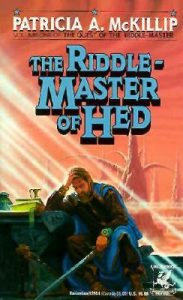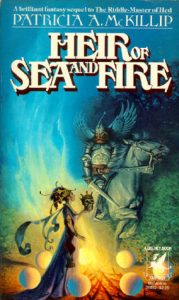The Riddle-Master’s Game by Patricia A. McKillip
 “Who is the Star-Bearer and what will he loose that is bound? What will one star call out of silence, one star out of darkness, and one star out of death? Who will come in the time’s ending and what will he bring? Who will sound the earth’s harp, silent since the Beginning? Who will bear stars of fire and ice to the Ending of the Age?”
“Who is the Star-Bearer and what will he loose that is bound? What will one star call out of silence, one star out of darkness, and one star out of death? Who will come in the time’s ending and what will he bring? Who will sound the earth’s harp, silent since the Beginning? Who will bear stars of fire and ice to the Ending of the Age?”
From Bilbo and Gollum trading riddles in the dark, riddles have a long and rich history in fantasy fiction. Significantly, riddles, and the ability to decode them, are frequently tied to prophecy. The heroes in a fantasy novel frequently have to interpret obscure clues left behind in ancient prophecies in order to figure out who to trust, which magical objects they will need, and how they must fulfil their destiny.
In the three books that make up The Riddle-Master’s Game trilogy, Patricia A. McKillip explores the idea of the hero as riddle-master, a person who resolves conflict and realises their destiny through the accumulation and interpretation of knowledge, the ultimate source of power. The books also deliver an exciting and thoughtful story, with flavours of Celtic mythology, in which classic fantasy tropes, such as the Chosen One narrative, missing ancient civilisations, wizards and shape-changers are played with and revealed in a different light. In the process, the reader too must learn to interpret McKillip’s signs and hints, to unravel the strictures and meanings behind the riddles in her narrative, in order to unpack the complexity and ambiguity of her story.
The first volume, The Riddle-Master of Hed (1976), introduces us to Prince Morgon of Hed, the ruler of a small, peaceful island, marked by three stars on his forehead, all reference to which have been mysteriously removed from the libraries of the Riddle-Masters and wizards. Morgon just wants to marry Raederle of An and rule Hed in peace, but his life is soon threatened by mysterious shape-changers. Accompanied by Deth, the High One’s harpist, he resolves to make the long and perilous journey to Erlenstar Mountain to ask the High One, the ruler of the realm, about the shape-changers and the mystery of the stars on his face.
 The second volume, Heir of Sea and Fire (1977), focuses on Raederle, who, following Morgon and Deth’s disappearance at Erlenstar Mountain, goes to find out what happened to them, and in the process unravels her own inheritance from the shape-changers. In the final book, Harpist in the Wind (1979), Morgon and Raederle together journey to the ancient ruined city of Lungold to solve the mystery of the shape-changers and the disappearance of the High One once and for all, and to save the realm from the evil wizard Ghisteslwchlohm.
The second volume, Heir of Sea and Fire (1977), focuses on Raederle, who, following Morgon and Deth’s disappearance at Erlenstar Mountain, goes to find out what happened to them, and in the process unravels her own inheritance from the shape-changers. In the final book, Harpist in the Wind (1979), Morgon and Raederle together journey to the ancient ruined city of Lungold to solve the mystery of the shape-changers and the disappearance of the High One once and for all, and to save the realm from the evil wizard Ghisteslwchlohm.
Knowledge as power is one of the major themes of the trilogy. The land-law, by which the rulers of the different kingdoms of the realm maintain their power, manifests itself as a kind of heightened awareness and knowledge of everything within the kingdom, from where all the people are and what they are doing to the movements of animals and the position of every tree and blade of grass. This knowledge is controlled and meted out by the High One, who, because of this knowledge of the land, is the most powerful being in the realm. Morgon’s prophecised journey, hidden by the wizard Ghisteslwchlohm because of the threat it poses to his power, is one of knowledge and discovery, as he journeys through the land, learning not only the different skills of the land-rulers but also the different natures and characteristics of the different lands themselves.
However, great power also corrupts; the ancient civilisation of the Earth-Makers, vanished leaving only ruins by Morgon’s time, destroyed itself for the selfish gain of power. Ghisteslwchlohm’s lust for power is similarly destructive, untempered as it is by true understanding and compassion. Morgon is able to ascend to the High One’s power because of his love for the realm and his compassion for its people; the great suffering he undergoes in the process change him from naïvety to understanding the evil that people are capable of doing, and an important part of his journey is his refusal to take his revenge and his determination to be a man of peace. These qualities mark Morgon out as being worthy of such great power.
The story also deals with identity, or self-knowledge. All three of the main characters, Morgon, Raederle and Deth, are either running from their heritage or hiding their true identities. Morgon, though he is born the land-ruler of Hed, is marked as the Star-Bearer by the stars on his face, but keeps running from this one riddle that he, a great riddle-master, is afraid to solve. Raederle is descended from the Kings of An and shape-changers, but is afraid to embrace the great powers she has inherited from the shape-changers because they are Morgon’s and the realm’s enemies. Deth has been hiding his true identity from Morgon, Raederle and all of the land-rulers and people in the realm for over seven centuries while he plays a long and elaborate riddle game.
Over the course of the trilogy, all three characters must stop hiding from the truth and face their real identities. However a major theme of the novels is who you are, rather than what you are, that define you. Morgon discovers that he has the compassion and humanity to wield his great power for good rather than for destruction. Raederle realises that just because the shape-changers have been corrupted into evil by their power doesn’t mean that she cannot chose to do good instead. And Deth’s apparent betrayal of Morgon and the entire realm is revealed to be much more complex than at first it appears, with him having reasons for his actions and the courage and integrity to face and suffer the consequences.
The Riddle-Master’s Game, like much of Patricia A. McKillip’s work, shows a profound awareness of both the best and the worst of humanity. McKillip’s characters ring true because they run the full gamut of the human experience, showing how wonderful, loving and caring people can be at their best, but also exploring the horrific things they can do at their worst. Ghisteslwchlohm’s actions, from his deceptions of the other wizards and the destruction of Lungold to his methodical torturing of Morgon and his maiming of Deth, reveal a person who has placed their desire for power over everything else, and make him a genuinely frightening antagonist. His final fate is suitably horrific. On the other hand, the land-rulers, despite their differing customs, strange and magical habits, and the bizarre legends that have built up around them, all receive Morgon and Raederle welcomingly and come to their aid in the final battle against the shape-changers.
 The trilogy also shows off McKillip’s wonderful, poetic writing. McKillip has a reputation as one of the most lyrical writers in the genre, and she effortlessly demonstrates this throughout the three books. From the first book’s comedic opening scene, in which a hungover Morgon has a fight in his family farmhouse with his siblings, to the dramatic, unsettling conclusion of the third, her range of tone is incredible, her descriptions of the fantastical scenery of the realm vivid and breathtakingly beautiful, her dream-sequences full of haunting imagery and hidden meaning. Perhaps it is fitting, given her lyricism, that music and the harp are such a central image in the books.
The trilogy also shows off McKillip’s wonderful, poetic writing. McKillip has a reputation as one of the most lyrical writers in the genre, and she effortlessly demonstrates this throughout the three books. From the first book’s comedic opening scene, in which a hungover Morgon has a fight in his family farmhouse with his siblings, to the dramatic, unsettling conclusion of the third, her range of tone is incredible, her descriptions of the fantastical scenery of the realm vivid and breathtakingly beautiful, her dream-sequences full of haunting imagery and hidden meaning. Perhaps it is fitting, given her lyricism, that music and the harp are such a central image in the books.
The story would still not work, however, without compelling and believable characters. Morgon, Raederle and Deth are all nuanced and complex, and the books are moving because the love they share rings true. In the first book, one could mistake Raederle for simply a love interest for Morgon, however in the second volume she is given her own story and motivation, making her a fully fleshed out character in her own right who has desires, fears and agendas of her own.
Whilst The Riddle-Master of Hed is very much Morgon and Deth’s story, their temporary disappearance allows Heir of Sea and Fire to focus on other characters, Lyra, the land-heir of Herun, who feels she failed to protect Morgon, and Tristan, Morgon’s sister, allowing them to share their own adventure with Raederle. While McKillip’s love of Tolkien is clear throughout the book, she is not afraid to expand her own cast beyond Tolkien’s largely male characters.
Crucially, when Morgon and Raederle get together in Harpist in the Wind, their problems don’t simply end. They have disagreements about the best course of action, petty arguments when they get tired and stressed. However throughout it all their love and support for each other strengthens them and allows them to fully realise themselves. Perhaps even more interesting is Morgon and Deth’s love for each other, which keeps bringing the characters together even after Deth’s apparent betrayal of Morgon. Morgon finds himself at the heart of the centuries-long riddle game Deth has been playing, and one of the things that allows Morgon to survive is that their love reawakens Deth’s own humanity, something he thought lost after so many years. Their connection allows Deth to reconnect with his own true identity, which itself solves the central riddle of the series.
